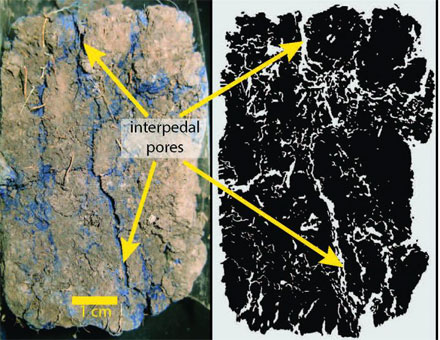The use of lasers to study soil hydrology (the movement of water through soil) may help soil scientists more accurately predict water flow.
Researchers at the University of Kansas have used a multistripe laser triangulation (MLT) scanner, originally developed for engineering purposes, to quantify macropores in soil from an excavation wall in northeastern Kansas in order to determine how the pore size in soil may help predict the preferential flow of water.
“A significant portion of water is transported through a relatively few number of large pores,” said professor Daniel Hirmas, of the University of Kansas. “Simply put, a soil pore that is twice as large as another will conduct sixteen times the volume of water as the smaller pore in the same amount of time. Soil scientists refer to this as preferential flow.”

On left, the blue color shows where most of the water flowed during the experiment. On right, the MLT scanner was able to reasonably differentiate between those pathways and smaller pores. Courtesy of D. Hirmas/University of Kansas.
To determine if the MLT scanner could be used to predict preferential flow, Hirmas and his research team took saturated soil and allowed blue dye to flow through the sample. An easily identifiable visible pattern developed. The areas of the soil that turned blue showed larger pores. These pores allowed the dyed water to pass through, thus demonstrating a preferential flow pattern. Next, they took the same soil sample, and scanned it using MLT. The pattern from the laser significantly matched that of the dye pattern.
The MLT scanner was able to detect and map the soil macroporosity in dry versus saturated soil. The researchers measured soil water contents at four depths within a soil lysimeter installed within 2 m of the MLT-scanned soil profile. Selected hydraulic properties of soil horizons within the lysimeter were optimized to water content data. Estimates of saturated hydraulic conductivity, or Ks, varied between 4198 cm d-1 in the A horizon and 0.6 cm d-1 in a 2Btss2 horizon (silty clay sample). Approximately 87 percent of the variation in Ks was explained by the geometric mean of the widths of pores quantified with the MLT technique.
“This technique shows promise in better understanding and predicting the relationship of soil structure to water flow,” said Hirmas.
Using lasers in the study of soil hydrology may lead to more efficient use of water for food production and better management of water resources in drought-prone areas. It could help scientists anticipate water runoff and soil erosion, deposition, and sedimentation of surface water reservoirs. It could also help predict how specific regions will be affected by climate change.
The research was published in Vadose Zone Journal (doi: 10.2136/vzj2015.05.0083).
On left, the blue color shows where most of the water flowed during the experiment. On right, the MLT scanner was able to reasonably differentiate between those pathways and smaller pores. Courtesy of D. Hirmas/University of Kansas.
On left, the blue color shows where most of the water flowed during the experiment. On right, the MLT scanner was able to reasonably differentiate between those pathways and smaller pores. Courtesy of D. Hirmas/University of Kansas.